The Supermicro Simply Double is one of the company’s most popular storage platforms. It is also one that we have wanted to review on STH for generations, but have not had the chance to. Normally, we would cover the platform at trade shows, but without trade shows in 2020, that is hard to get hands-on time. For those running object storage solutions, such as Ceph, the Simply Double is designed to provide the right core to disk ratio.
Video Version
This is part of our visit to Supermicro HQ post-lockdown series. We previously looked at the Supermicro SYS-240P-TNRT 4P 3rd Gen Xeon Scalable Server which we showcased alongside the Cooper Lake launch. As a part of that series, we have an accompanying video:
We are going to have more detail in this article, but want to provide the option to listen. As a quick note, Supermicro filmed the video bits at their HQ, provided the systems in their demo room, and their product managers that were able to make it. We did a whole series but are tagging this as sponsored since we relied upon their facilities instead of our own. I was able to pick the products we would look at and have editorial control of the pieces (nobody is reviewing these pieces outside of STH before they go live either.) In full transparency, this was the only way to get something like this done, including looking at a number of products in one shot, without going to a trade show during shelter-in-place. Look for more in this series coming to STH over the coming weeks.
Supermicro Simply Double
The Simply Double system we saw was the SSG-6029P-E1CR24H which is an almost gratuitously long product name. From most of the product shots, one will immediately see one of the most recognizable features of the 2U server, the mid-plane 12-bay section. With 12 front panel bays along with the 12 bays in the middle of the chassis, one gets 24x 3.5″ drives and a dual Xeon server in only 34″ (863mm) of server depth.
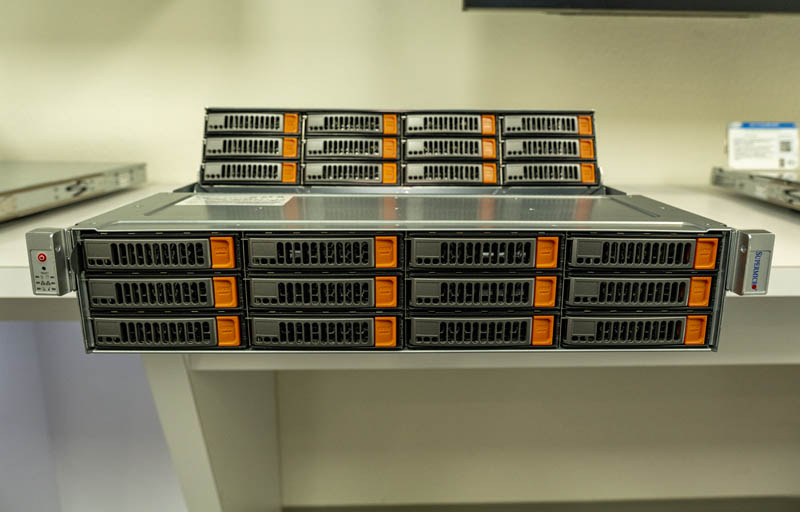
Something I noticed immediately standing in front of the unit is that the drive bays were not a typical Supermicro 3.5″ tray. Instead, they seemed slightly slimmer. They also had a gray/grey color instead of a straight black color. In most Supermicro servers, the orange tabs mean NVMe, but in this case, those are standard SAS/SATA bays (although Supermicro does have a 2.5″ NVMe solution that we did not look at as well.)
With some hands-on time, I was finally able to see what makes this solution work. Each of the twelve drive bay segments has its own expander backplane. The pop-up drives “riser bays” sit in the middle of the chassis and have a cable management channel along the rear to keep cables in-place as the assembly moves.
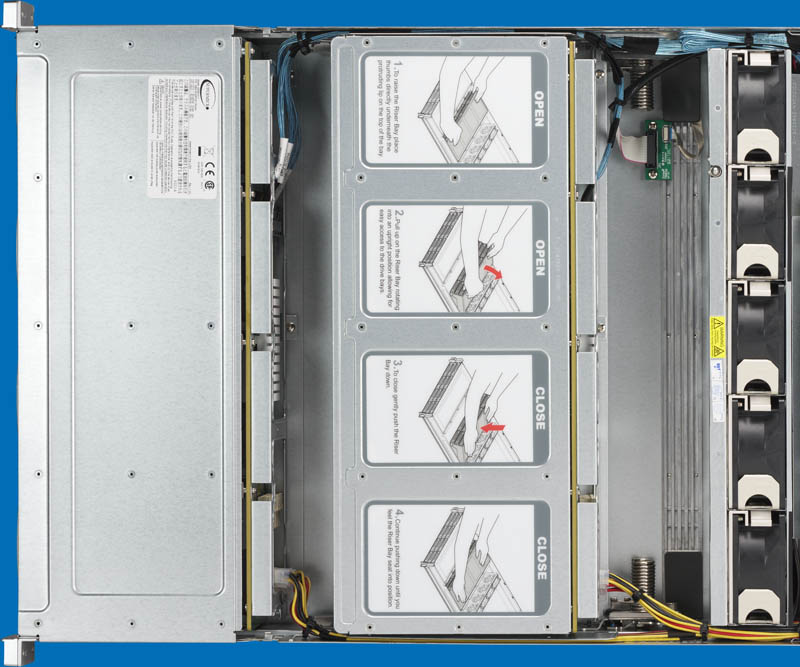
The springs themselves were much heavier than I was expecting but they are designed not just for the up and down motion, but also to provide smooth motion and support for servicing drives. One other small feature that I had not noticed before is that Supermicro has an additional cross brace in the steel chassis just in front of the fans. I asked and this is to anchor the entire riser bay assembly. The below photo has its white balance adjusted so you can see the contrast of this brace a bit more clearly.
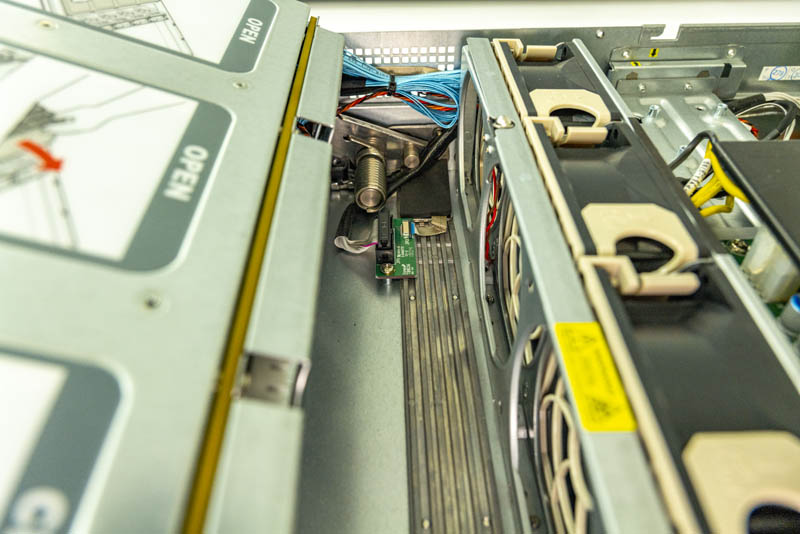
The rear of the chassis is also quite different than what we would otherwise expect as well. There are two 2.5″ bays, primarily for boot devices. One also has fairly standard sets of ports. In the platform we saw, there are three low-profile PCIe expansion slots (1x PCIe 3.0 x8 and 2x PCIe 3.0 x16) for networking and storage. There is even a SIOM networking slot along the bottom edge.

The power supplies are not in a typical Supermicro server position. Instead, they are mounted higher in the chassis more centered instead of along an edge (typically the bottom left on Supermicro 2U servers.) That is because they sit above a dual Xeon Scalable server platform.
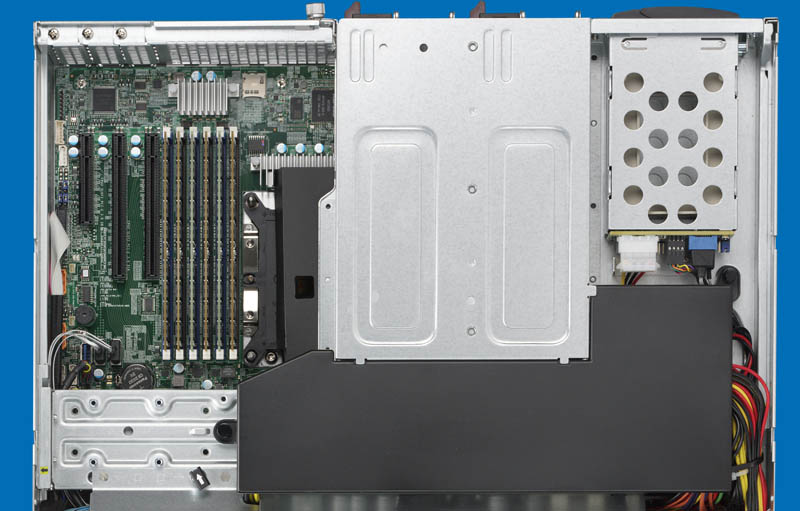
At the heart of the system, there are two Intel Xeon Scalable processors. This system can take first and second-generation CPUs up to 165W TDP. Why this is important is because they can be configured with 2nd Gen Intel Xeon Scalable Refresh SKUs that are low power, lower cost, and can support one core per drive. For example, one 12-core CPU matches to the front panel 12-bays while the second 12-core CPU matches to the riser bays.
That makes the solution ideal for a lot of applications such as object storage where Supermicro has had a lot of success with these servers. In previous generations, 12-core CPUs were much more expensive, but now those SKUs reside in the Silver 4200 and Gold 5200 lines which offer a solid price-TDP-performance combination for these types of applications.
Further, one can add features such as DCPMM to the system adding more inexpensive memory or persistent storage to the solution.
Final Words
Many servers we review are variations on fairly standard server designs. The Supermicro Simply Double is something else since it is highly tailored to delivering not just 24x 3.5″ bays in a 2U chassis, but also the role of a scale-out storage platform. Many data centers are designed to have one server per 2U in terms of density from a rack, power, and switch standpoint. Having a 2U form factor that is able to deliver higher storage density along with the right ratios of CPU cores to physical drives makes a lot of sense.
If you want to see the drive riser bays, a name slightly confusing with most thinking of PCIe when they hear of “risers”, in action, then you can check out the video above at about 3:06 where I push the riser bays in. Normally, I get to try these servers hands-on at trade shows but without them this year, part of the reason I asked Supermicro to bring this server around when I stopped by HQ was that I wanted to try this. I was a bit surprised with how stiff yet easily it moved. After seeing the springs and cross brace mechanism in-person, my sense is that this design was specifically built to deliver that type of experience.
Hopefully, you found this piece interesting. We have several more of these coming from my visit to Supermicro since it is unlikely we will see these systems at trade shows any time soon.

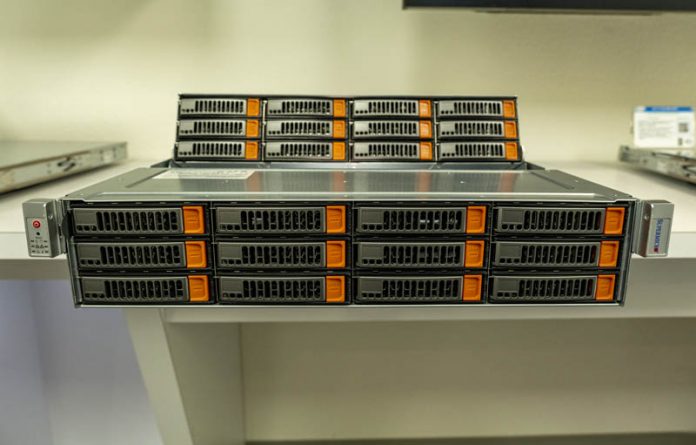



We have well over a hundred of these installed if you include the E5 v4 gen as well. They’re great servers and we’re looking at doing optane in the next one for write cache instead of NVMe. They’ve also got an option to add NVMe to some of the flip up bays
We had a rack of these which isn’t as many as others but can you give them a product suggestion. Can they do 7mm drives on the back for SSDs and maybe get 4?
I’d also tell you you have to pull them out, not all the way, but some to service those drives. Remember to leave cable length so that is possible.
They should build this with a single AMD Epyc board and room for network and PCIe SSD. Would be an epyc :) Ceph node.
I don’t understand why vendors are so lacks to get into the AMD segment (single socket storage and single socket GPU enabled servers).
Of course that should be “lax”…
Indeed, it seems that SM is really reluctant to use AMD in it’s really good and efficient designs.
We used a 1U AMD server paired with 2 simply-double jbods (that have IPMI) and from the math on our use-case we can safely (meaning no bottleneck) use 4 jbods with 2x25gbps nic
I like this form factor, personally I prefer the way that Dell implements it with the R740xd2 as there is no need to slide the unit out at all to service the back drives. We have some of the R740xd2 units and they are very nice.